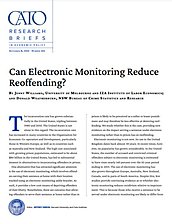The incarceration rate has grown substantially in the United States, tripling between 1980 and 2010. The United States is not alone in this regard. The incarceration rate has increased in many countries in the Organisation for Economic Co-operation and Development, particularly those in Western Europe, as well as in countries such as Australia and New Zealand. The high cost associated with growing prison populations, estimated to be about $80 billion in the United States, has led to substantial interest in alternatives to incarcerating offenders in prison.
One alternative that has attracted significant attention is the use of electronic monitoring, which involves offenders serving their sentence at home with their location tracked using an electronic monitoring ankle bracelet. As such, it provides a low-cost means of depriving offenders of their liberty. Nonetheless, there are concerns that allowing offenders to serve their sentence at home rather than in prison is likely to be perceived as a softer or lesser punishment and may therefore be less effective at deterring reoffending. We study whether this is the case, providing new evidence on the impact serving a sentence under electronic monitoring rather than in prison has on reoffending.
Electronic monitoring is not new. Its use in the United Kingdom dates back almost 30 years. In recent times, however, its popularity has grown considerably. In the United States, the number of accused and convicted criminal offenders subject to electronic monitoring is estimated to have risen nearly 140 percent over the 10-year period ending in 2015. The use of electronic monitoring has also grown throughout Europe, Australia, New Zealand, Canada, and in parts of South America. Despite this, few studies provide convincing evidence as to whether electronic monitoring reduces recidivism relative to imprisonment. This is because those who receive a sentence to be served under electronic monitoring are likely to differ from offenders sentenced to prison in observable ways, such as having committed less-serious offenses, and in unobservable ways, such as exhibiting greater remorse, that make them less likely to reoffend. As a consequence, the causal effect that serving a sentence under electronic monitoring rather than in prison has on reoffending is difficult to identify. We account for this issue by using a proxy variable measuring the tendency of a randomly assigned judge to refer eligible cases for electronic monitoring. This proxy variable can be used to measure the impact of electronic monitoring on reoffending because judges differ in the likelihood that they will refer an individual for monitoring and because of the random assignment of such judges.
A second difficulty with research seeking to evaluate the impact of electronic monitoring on recidivism is that electronic monitoring is not a single, well-defined form of intervention applied at a particular stage in the criminal justice process to a defined set of offenders. Electronic monitoring has been used as an alternative to pretrial detention; as an alternative to a custodial sentence served in prison; as a condition of bail; as a requirement of community and suspended-sentence orders; and as a form of early release. In some jurisdictions it can be used for any type of offense, including violent offenses, whereas other jurisdictions limit its use to nonviolent and less-serious offenses. In this paper, we study electronic monitoring used as a front-end alternative to a custodial sentence served in prison for nonviolent offenders.
To evaluate the impact serving a sentence under electronic monitoring has on reoffending, we draw on detailed individual-level administrative data from courts, prisons, and corrective services for a large urban population. Our baseline model examines reoffending within 24 months for offenders of all ages. Estimates from this specification show that serving a sentence under electronic monitoring rather than in prison reduces reoffending from 58 to 42 percent (16 percentage points). This effect is robust to accounting for time spent under electronic monitoring and is not driven by those who have been previously imprisoned. The reduction in reoffending is, however, found to be concentrated among offenders who are less than 30 years old. For this group, serving a sentence under electronic monitoring rather than in prison reduces the probability of reoffending within 24 months from 64 to 21 percent (43 percentage points).
We also investigate the extent to which the reduction in reoffending that occurs within 24 months of the offender being freed persists or fades out at longer durations of follow-up. To do so, we examine reoffending out to a 10-year horizon. When considering offenders of all ages, we find that the reduction in reoffending persists to five years of being freed. For those who are under 30, the reduction in reoffending persists to eight years of being freed.
Finally, we combine our estimates with information on criminal justice costs to provide a sense of the budgetary implications of diverting offenders from prison to electronic monitoring. Our back-of-the-envelope calculations show that each offender who serves his or her sentence under electronic monitoring rather than in prison saves the public purse close to $30,000 on reduced supervision and future court and prison costs.
Note:
This research brief is based on Jenny Williams and Donald Weatherburn, “Can Electronic Monitoring Reduce Reoffending?,” IZA Institute of Labor Economics Discussion Paper no. 12122, January 2019, https://ssrn.com/abstract=3390109.

This work is licensed under a Creative Commons Attribution-NonCommercial-ShareAlike 4.0 International License.
